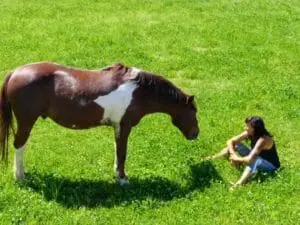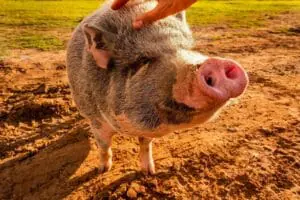One of the most difficult things a person or family can experience is the traumatic loss of a loved one. A traumatic loss is unexpected, violent, or involves a person who should not yet die, like a child. For people who experience these losses, traditional therapy may be inadequate: the therapist may not understand the depth of the person’s pain, the setting may be too sterile, and there may be a push toward try psychotropic medications rather than nonmedical alternatives.
Dr. Joanne Cacciatore - senior sustainability scholar in the Julie Ann Wrigley Global Institute of Sustainability and associate professor in the School of Social Work – is developing a new approach. Her paper, Evaluating care farming as a means to care for those in trauma and grief, outlines her approach. Dr. Cacciatore operates the Selah Carefarm - C.A.R.E. stands for counseling, advocacy, research and education - which takes people into nature to hang out with and care for animals. Researchers know that engagement with nature has positive physiological effects. Even more, contact with animals lowers stress hormones (cortisol), heart rate, and blood pressure. Greencare therapy, of which care farming is an example, facilitates individuals’ interactions with nature with the intent of providing a health benefit.
In Dr. Cacciatore’s study, grieving parents and siblings visited a care farm housed on 10 acres in northern Arizona. Interventions took place during 10-hours spread over two consecutive days. Participants received traumatic grief counseling for four to six hours over those two days; during off hours they explored the nature spaces and interacted with and cared for the animals, including horses, donkeys, pigs, sheep, goats, dogs and cats. Each of the animals had been rescued from abuse, neglect, and/or homelessness, and they were allowed interact with people only as much as they chose. Participants were invited to hear the animals’ stories and to engage in rituals, such as creating a memorial rock to their loved one.
Qualitatively, participants reported a significant reduction of grief intensity between pre- and post-tests. Many said they felt very safe; safety is a feeling that is often lost after a traumatic event. Interacting with the animals after intensive therapy helped the people decompress, reflect on, and process the therapy. Participants felt connected to the animals, due to their shared history of trauma. In this paper, Dr. Cacciatore suggests bereavement support be personalized and take place within a therapeutic community separate from everyday life where participants are free to explore and process emotional trauma. More needs to be learned about these alternative therapies as a replacement for psychotropic medications for supporting people who are experiencing traumatic grief.

